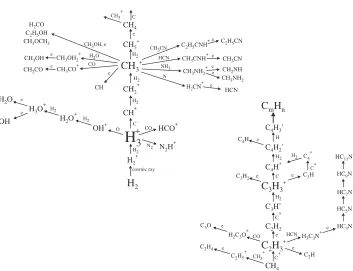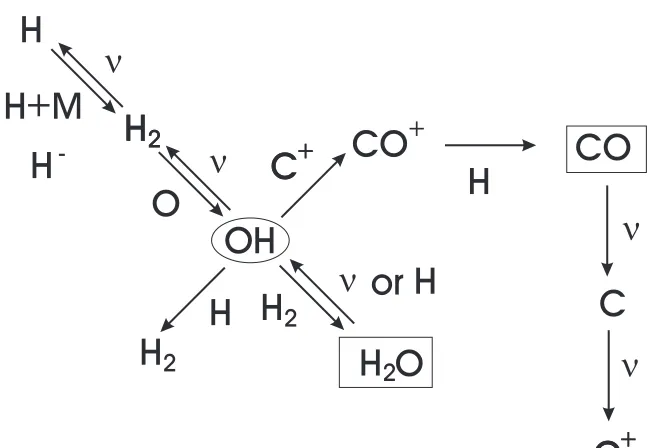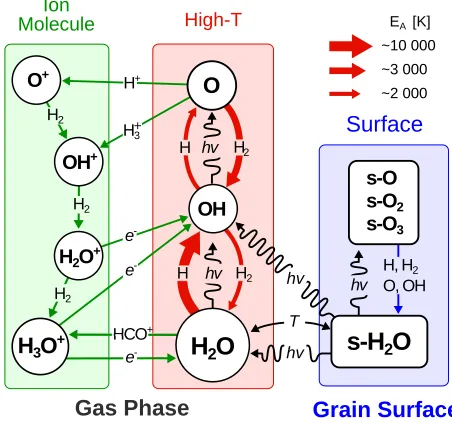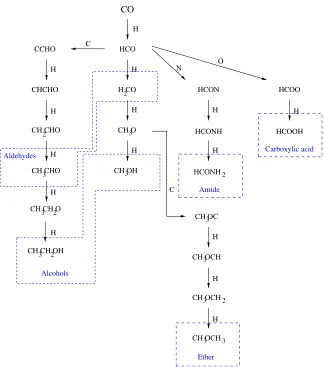Chemical networks
Wing-Fai Thi
1MPE, Garching, Germany
Abstract.This chapter discusses the fundamental ideas of how chemical networks are build, their strengths and limitations. The chemical reactions that occur in disks combine the cold phase reactions used to model cold molecular clouds with the hot chemistry applied to planetary atmosphere models. With a general understanding of the different types of reactions that can occur, one can proceed in building a network of chemical reactions and use it to explain the abundance of species seen in disks. One on-going research subject is finding new paths to synthesize species either in the gas-phase or on grain surfaces. Specific formation routes for water or carbon monoxide are discussed in more details.
1 How to construct a chemical network for protoplanetary disk chemistry?
A chemical network is a group of elementary reactions governing the transformations of chemical species and reproducing the relationship between molecules in a medium. Several general rules based on chemical considerations govern gas-phase chemical networks:
- The most abundant atoms or molecules are the most probable reaction partners. As H2is the most abundant molecule , reactions involving this latter molecule will dominate the chem-istry. Reactions involving O, C, C+, and N are also important when they are abundant in UV-dominated regions.
- The main loss channels for ions is the reaction with H2 (the most abundant potential reaction partner), or electron recombination (characterized by larger rate coefficients). One should not forget that free electrons are abundant in a medium populated by cations.
- Charges on PAHs and grains should be included because recombination rates become much smaller.
- Reaction rate coefficients for ion-neutral reactions are significantly higher (they are temperature-independent) than for neutral-neutral reactions at low temperatures. For this rea-son, ions will dominate the chemistry. Ionizing agents are therefore very important for gas-phase astrochemistry, whatever the environment considered. At disk surfaces, ionization will occur through the action of ultraviolet light. In denser shielded parts, the interaction of high energy charged particles (cosmic-rays) with neutral species will ionize the medium. A prob-able channel for this ionization process is the ionization of abundant He atoms, followed by 13thLecture of the Summer School “Protoplanetary Disks: Theory and Modelling Meet Observations”
/ C
Owned by the authors, published by EDP Sciences, 2015
/ 102
charge transfer to other neutral species. The action of other ionizing agents that can penetrate towards the disk midplane (X-rays) or are locally produced (radiative decays) should be taken into account.
- In dense gases, carbon and hydrogen are mostly found in molecular species, and the dominating ions are H+3, HCO+and H3O+. Here again the role of He+should not be neglected.
- If there is a lack of dominating ions, neutral species will react most probably with small radicals (atoms or diatomic molecules).
- Surface chemistry is central to form many species. One should include also UV-photolysis surface reactions.
1.1 Deterministic rate equations
Traditional phenomenological kinetics uses first-order ordinary differential equations (ODEs) to de-scribe the rate of change of the species in a chemical reaction. The solution to these equations provides expressions for the concentration of each species as a function of time. The use of ODEs to describe rate laws implies that concentrations are continuous quantities. As a consequence, this model is de-terministic and provides exact solutions with no uncertainty involved.
During a chemical – or photochemical – process, chemical species are destroyed and other chemi-cal species are formed. We can consider formation and destruction rates for various kinds of reactions:
- unimolecular reactions A→C
−dn(A)
dt =k n(A)= dn(C)
dt
- bimolecular reactions A+B→C −dn(A)
dt =k n(A)n(B)= dn(C)
dt
- t(h)ermolecular reactions A+B+M→C+M −dn(A)
dt =k n(A)n(B)n(M)= dn(C)
dt
In these relations, the temporal derivatives are reaction rates, and the factors (k) preceding the numerical species densitiesnare reaction rate coefficients, also called kinetic constants. The reaction rates are always expressed in cm−3s−1 (c.g.s.), whilst the units of reaction rate coefficients depend on the type of reaction. For instance, for bimolecular reactions,kis expressed in cm3s−1, while for unimolecular reactions,k is expressed in s−1. The number of coupled differential equations to be solved is equal to the number of species minus the mass conservation equations.
2 Chemical databases
2.1 Chemical modeling: completeness and uncertainties
The outcome of chemical models is ultimately limited by fundamental issues such as the limited num-ber of species considered, the non-complete set of reactions, the lack of actual experimental and/or theoretical values for many rates, and the elemental abundances. A couple of species show a strong time-dependence in their abundances, causing also a dependence on the initial state of the gas (atomic or fully molecular). One is naturally tempted to include all the known species and reactions but this procedure may be counterproductive for the accuracy in the computed abundances due to the un-certainties in many rates in addition to the numerical burden of solving simultaneouslyn coupled differential equations (the number of operations is∼nlog(n)). Keeping in mind the limitations, the chemical modeling of disks has been quite successful in providing insights to the observed abun-dances.
3 Cold gas chemistry: Ion-neutral chemistry network
At 10 K, and in the absence of a strong UV field, ion-neutral and dissociative recombination reactions are among the fastest. A couple of neutral-neutral reactions have also shown enhanced rates at low temperatures. The chemistry is initiated by the ionization by cosmic-rays of molecular hydrogen H2
+CR−→H++H+e, leading to the formation of H+3 via H+2. H+3 is the key species in the chemical networks in low temperature dense gases. Once H+3 is present, it can either recombine with an electron or react with other abundant species such as H2, atomic oxygen, or CO to synthesize most of the gas-phase molecules detected in the outer regions of protoplanetary disks. Indeed the H+3 ion has a propensity to transfer a proton to neutral species with higher proton affinities than H2. The chain of reactions lead to molecular cations that can not grow further. At this stage the cations will recombine dissociatively with electrons to form neutral species like OH, H2O as discussed earlier (Fig. 1)
The chemical scheme starting with H+3 has been quite successful in explaining the abundances of many species in molecular clouds. The efficiency of the scheme in the inner disk midplane will depend on the penetration depths of cosmic-rays and on other sources of ionization (radioactive decay and X-rays). Once formed, neutral species such as OH and H2O can quickly freeze onto grain surfaces.
3.1 Nitrogen chemistry network
Atomic nitrogen does not react with H+3 contrary to neutral atomic oxygen and carbon. The reaction of ground state atomic nitrogen with H+3 is prohibited due to an activation barrier for one reaction pathway whilst a second pathway is endothermic. Instead of reacting with H+3, N reacts with the OH radical in a reaction involving a small activation barrier of 14.9 K. The rate is uncertain within a factor 10. Once NO is formed, it has to react with another nitrogen atom to form N2. This is the key species in the nitrogen chemistry, for example in the formation of N2H+, a cation that has been detected in disks. The other path is the reaction of atomic nitrogen with CH to form CN. The formation of OH and CH require a few reaction steps; therefore the formation of nitrogen-bearing species occurs at a late stage in time-dependent chemical models.
4 Chemical network for warm dense gases
Figure 1.Chemical network driven by H+3. The left hand part connects with its lower end to the top of the right hand part.
4.1 CO formation and destruction
CO molecules are readily formed for all values of the UV field enhancement when the density reaches values of≥106cm−3and temperature (T) values below 2500 K. The formation of CO is initiated by the fast reaction at high temperature (activation energy ofEa=3150 K)
H2+O→OH+H (1)
followed by the reaction
C+OH→CO+H, (2)
which has a rate of 1.10×10−10(T/100)1/2s−1. The other channel
C+OH→O+CH (3)
has an activation energy of 14800 K.
Above 3000 K, destruction of CO is enhanced because reactions with high barriers are activated. Especially, CO is chemically dissociated at gas temperature greater than 3000 K by the endothermic reaction
H+CO→C+OH (4)
Figure 2.Gas-phase nitrogen chemistry network (Le Gal et al. 2014, reproduced with permission cESO).
At lower UV intensities, CO reacts with OH+ to form HCO+. Here OH+ originates from the reaction between H+3 and atomic oxygen (Fig. 1).
At extreme densities, CO is formed directly from the neutral-neutral addition C +O and the excess energy is carried away by a third body, most likely a hydrogen atom. The main CO destruction reaction besides photodissociation is the hydrogenation of CO leading to HCO. If the abundance of H2is not sufficiently high
CO+H+M→HCO+M. (5)
Another possible reaction is
CO+H2+M→HCO+H, (6)
where M is a third body (likely H or He). Alternatively, with low H2abundance, CO preferably reacts with OH to form CO2
CO+OH→CO2+H. (7)
Finally, the reaction
HCO+H+M→H2CO+M (8)
H
C
CO
OH
H
2
H M
O
n
+
C
H
2
H
2
O
+
C
+
CO
H
n
n
+
C
+
C
n
or
H
H
+
n
H
2
H
2
H
-Figure 3.Chemical network driven by OH.
4.2 Water molecules
The chemical reactions leading to water molecules in cold and hot regions are different. In quiescent molecular clouds, the gas temperature is below 230 K and gas-phase chemistry gives typical H2O abundances of a few×10−7 (van Dishoeck et al. 2014). Water is formed by a sequence of ion-molecules reactions starting with O+H+3 or O+ +H2 leading to OH+. Then rapid H-abstraction reactions with H2 produce H3O+, which dissociatively recombines (with electrons) to form H2O. Another potential source of gas phase water molecules is the evaporation of icy grains in regions whereT>100 K. The reaction scheme in cold regions has been proven to be too effective in producing H2O, when compared to observations of high-mass star forming regions. At high temperature (Tgas> 230 K) and densities lower than 1015cm−3, water molecules are predominately formed via the radical-molecule reaction
H2+OH→H2O+H (9)
since OH is very abundant. The importance of this reaction was already realized for water formation in shocks (Bergin et al. 1998; Elitzur 1979). Water molecules are mostly destroyed by photodissociation and by reaction with C+
H2O+C+→HOC+/HCO++H. (10)
Depending on the gas and dust conditions, gas-phase water and water ice can be formed via different paths as illustrated in Fig. 4.
4.3 Formation of organic molecules
!"""" """ """
Figure 4. Chemical pathways of water formation (figure from van Dishoeck et al. 2014, from Protostars and Planets VI by Beuther et al. c2014, the Arizona Board of Regents, reprinted by permission of the University of Arizona Press).
CH
4CH3 CH2
CH
C
H2 H2 H2 H2Ae~12000 K Ae~1500 K Ae~4000 K Ae~4000 K
C H
2 2C H2 C2
H2 H2
Ae~1500 K Ae~1300 K
HCN
CN H2
Ae~1200 K
C
+ CH2 + CH3 + H2 H2 e -e -C2 +C H2
+ C H
2 2 +
H2
H2
C H2 3 +
H2
e
-e- e
-NO
N
OHN N
C
C C
C+ C+
C
N
CH5 +
H2
CO, H O2
hn hn
Ae~ 4000 K
CH+
H2 H2
hn
H2
Figure 5. Warm gas chemical network leading to the formation of C2H2 (figure from Agúndez et al. 2008, reproduced with permission cESO).
5 Surface chemistry network
same. Also reactions can occur between an adsorbed species and a gas-phase species (Eley-Rideal mechanism). The computation of the surface reaction rates is relatively straight-forward in the rate equation treatment (Hasegawa et al. 1992). The computation of the rate of surface reactions requires the knowledge of the diffusion energies for various grain surfaces and of the activation barrier en-ergies. The diffusion energies are seldom estimated directly from laboratory experiments. In the absence of known diffusion energies, one has to rely on a scaling of the adsorption energies with a factor that varies from 1/3 to 1/2 depending of the authors. The scaling factor can be the same for all reactions or can vary from reaction to reaction. But again the adsorption energy for large species is in many cases not well determined experimentaly. For large species with many functional groups, one approximation is to add the adsorption energy of each group present in the molecule.
The mobility of a species on grain surfaces depends thus on its adsorption energy. Most reactions happen between one mobile species and a non-moving species. Among the most abundant reactive species, hydrogen atom will be the most mobile. Hydrogenation reactions are the most likely to occur on grain surfaces. Figure 6 shows an example of surface chemistry path starting from adsorbed CO, which is formed in the gas-phase, and leading to complex molecules by mostly hydrogenations but also by additions of simple atoms (oxygen, carbon, and nitrogen). Unfortunately, the adsorption and diffusion energies are still not precisely determined for many species. Atomic hydrogen is a minor species in molecular gases and it abundance depends for instance on the H2 formation and photodissociation and the cosmic-ray flux. Therefore surface reactions may reflect indirectly other gas processes. For example, the synthesis of methanol (CH3OH) on grain surfaces start with the hydrogenation of adsorbed carbon monoxide, which was formed in the gas-phase, followed by three subsequent hydrogen additions. Two of the reactions have energy barriers, whose values are subject to strong debates among physico-chemists. Higher dissociation rate of H2, either via X-ray or cosmic-ray may result in high methanol ice formation. But since methanol has a high adsorption energy (5500 K), one of the issue in surface chemistry is to have a mechanism to populate the gas-phase of the species formed on grain surfaces.
When a reaction entails an activation barrier, it can still occur by tunnelling. Since the lighter the surface species the more likely it can tunnel, again hydrogenation will dominate. Tunnelling by species heavier than atomic hydrogen is disputed. It can been invoked to ease the formation of CO2 ice on grain surface via the CO+O addition, which has a large barrier. Laboratory works suggest that atomic oxygen can indeed tunnel (Congiu et al. 2014).
Addition reactions are not the only type of surface processes. Others should be taken into account: photodesorption, UV process of surface species, cosmic-ray heating. One should keep updated with the on-going literature. Given the complexity in building a surface chemistry network and in its treatment, there is no consensus on "ready-to-use" networks although a few networks are starting to be used by various authors.
6 Surface chemistry: Monte-Carlo vs rate equation treatment
Figure 6. Standard surface chemistry paths showing mostly the hydrogenation sequences leading to complex surface species with different functional groups (in blue). All the large species in this schematics are frozen onto grain surfaces. The species can evaporate to the gas either by thermal desorption, photodesorption, cosmic-ray heating of the grains, or use the energy of the reaction. The atoms (C, H, O, N) can either be already on the grain surfaces (Langmuir-Hinselwood type of surface ractions) or can come from the gas phase (Eley-Rideal mechanism). A few reactions have energy barriers.
7 Isotopolgue networks
8 Final words
Building a chemical network for protoplanetary disks is challenging as it involved rates that are to be known for a large range of temperatures, densities, UV, and X-ray field.
AcknowledgementsThe research leading to these results has received funding from the European Union Seventh Framework Programme FP7-2011 under grant agreement no 284405.
References
Agúndez, M., Cernicharo, J., & Goicoechea, J. R. 2008, A&A, 483, 831
Agúndez, M. & Wakelam, V. 2013, Chemical Reviews, 113, 8710
Albertsson, T., Semenov, D., & Henning, T. 2014, ApJ, 784, 39
Bergin, E. A., Melnick, G. J., & Neufeld, D. A. 1998, ApJ, 499, 777
Congiu, E., Minissale, M., Baouche, S., et al. 2014, Faraday Discuss., 168, 151
Du, F. & Bergin, E. A. 2014, ApJ, 792, 2
Elitzur, M. 1979, ApJ, 229, 560
Hasegawa, T. I., Herbst, E., & Leung, C. M. 1992, ApJS, 82, 167
Henning, T. & Semenov, D. 2013, Chemical Reviews, 113, 9016
Le Gal, R., Hily-Blant, P., Faure, A., et al. 2014, A&A, 562, A83
McElroy, D., Walsh, C., Markwick, A. J., et al. 2013, A&A, 550, A36
Roueff, E., Loison, J. C., & Hickson, K. M. 2015, A&A, 576, A99
van Dishoeck, E. F., Bergin, E. A., Lis, D. C., & Lunine, J. I. 2014, Protostars and Planets VI, 835
Walsh, C., Millar, T. J., & Nomura, H. 2010, ApJ, 722, 1607




